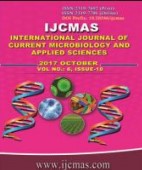


 National Academy of Agricultural Sciences (NAAS)
National Academy of Agricultural Sciences (NAAS)

|
PRINT ISSN : 2319-7692
Online ISSN : 2319-7706 Issues : 12 per year Publisher : Excellent Publishers Email : editorijcmas@gmail.com / submit@ijcmas.com Editor-in-chief: Dr.M.Prakash Index Copernicus ICV 2018: 95.39 NAAS RATING 2020: 5.38 |
A field experiment was conducted during Rabi 2012-13 and 2013-14 to study economics of cost of cultivation head yield and seed yield of cabbage as influenced by different sources and levels of sulphur. The experiment was laid in a randomized block design with three replications. Three sources of sulphur i.e., gypsum, elemental sulphur and potassium sulphate with three levels i.e., 40, 70 and 100 kg S ha-1 for each source were tried in the experiment. Pooled data of two years showed potassium sulphate as a source of sulphur recorded maximum head yield plot-1 (30.8 kg) and head yield ha-1 (408.4 q) and seed yield per plant (12.9 g), and seed yield per hectare(4.8 q). Further, increasing levels of sulphur up to 70kg ha-1 showed significant results. Maximum cost of cultivation ( 230577.5 ha-1) and ( 242390.0 ha-1) was estimated in application of 100 kg S ha-1 as Elemental sulphur and minimum ( 130577.5) and ( 130577.5) under control for head yield and seed yield of cabbage, respectively. Optimum dose of sulphur registered net returns of 404251.3 ha-1 and of 271457.3 ha-1 with B: C ratio of 3.4 and 2.5 for cabbage head and seed production respectively. Economic studies indicated that fertilizer source Potassium Sulphate @ 70 kg S ha-1 gave maximum net returns of 485925.8 ha-1 and 3210128.0 ha-1 with B:C ratio of 4.1 and 3.0 for cabbage head and seed production respectively.
 |
 |
 |
 |
 |